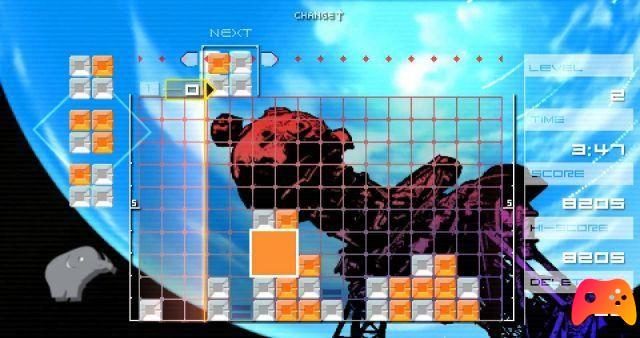
Exactly ten years ago PlayStation Portable was launched on the European markets, after months of waiting compared to Japan and the United States. PSP represented Sony's debut in the world of handhelds, a Sony that came out of ten years of absolute domination of the home console landscape. Someone believed it at the time, someone was convinced that there were the conditions to unseat Nintendo even in this area, in which the Big N has never had a competitor up to it. Then we know how things went ...
VGNetwork / Epic Videogames Guide has decided to celebrate the first ten years of PSP (for us Europeans, we mean) by offering you the review of Lumines, the best title of the console's starting line-up, as well as one of its killer applications.
Look + music = skin
As anticipated, Lumines is a particular puzzle game, as it gives much greater importance to graphics and sound than its colleagues. Technically, the word skin refers only to cosmetics, thus involving the background and the chromatic choices, but in Mizuguchi's work a piece of music and a set of sound effects are linked to each skin; moreover, as we said in the previous paragraph, the skin also influences the speed of the "timeline" that clears the screen, since it moves in time with the music.
As already happened in Rez, graphics and sound combine with each other and interact with the gameplay, even if in a "superficial", indirect way. Lumines is not a hybrid between puzzle and rhythm game, it can also be played by a deaf person, but the best mode of use - the one designed by its author - is with headphones and a reasonably high volume. The sound affects the gameplay (the timeline above) and the gameplay affects the sound, since the moves made by the player (for example, a dash, i.e. a sudden movement of the tetramino along the horizontal axis) are underlined by a specific sound effect.
The work done is artistically very valid, both on the visual and on the sound side, thanks to the soundtrack of Mondo Grosso (mainly), an eclectic musician in the field of electronics, but not only. It's really a shame that Lumines II has completely changed its way, including in the soundtrack pop songs of the moment (Black Eyed Peas, Hoobastank, Gwen Stefani… mah, Ed); Electronic Symphony on PS Vita continues on the path of the compilation, but with probably more prudent choices (at least in my opinion, Ed). From a gameplay point of view, however, it should be noted that some skins, however beautiful, may be hardly "legible" and therefore frustrating, especially during the first approaches.
The nit
The modalities proposed by Lumines are relatively numerous, but, if we had to choose something to complain about, we would choose these. The variety is there all in all, but everything is a bit rigid.
Challenge mode is the main one, especially by virtue of the fact that it will allow you to unlock most of the 40 available skins. It consists very simply in the succession of skins, to be faced one after the other; once you pass a skin, it is unlocked and becomes playable in single theme mode. The problem is that the themes are always proposed in the same order and, to unlock them all, you have to face a couple of hours of challenge at a guess, without the possibility of saving and necessarily having to start over each time. Maybe you just miss the last skin, lose and… again from the first one. The same goes for the battle mode with the CPU, structured in ten levels to be won in succession and without intermediate bailouts.
Now let's take a look at the other modes, which allow you to unlock characters and other themes. The timed challenge requires you to create the largest number of squares in strict time frames (60, 180, 300 and 600 seconds). The clash of two is the local multiplayer mode, which however does not enjoy game sharing. Puzzle mode is the best alternative to challenge mode. It requires you to form figures (a dog, a giraffe, a cross, etc.) in a certain time. Very fun, even if not particularly long-lived; to extend her life, Q Entertainment has seen fit to add a second round, in which you have to reproduce the shape not once, but twice. Long live originality.
The small moles mentioned above do not unduly penalize Lumines, which may deserve the status of a masterpiece. On the other hand, it is true that modern games tend to add modalities to their playful offer, but a puzzle game needs other qualities to stand out: its mechanics must be addicting. And those of Lumines are.






